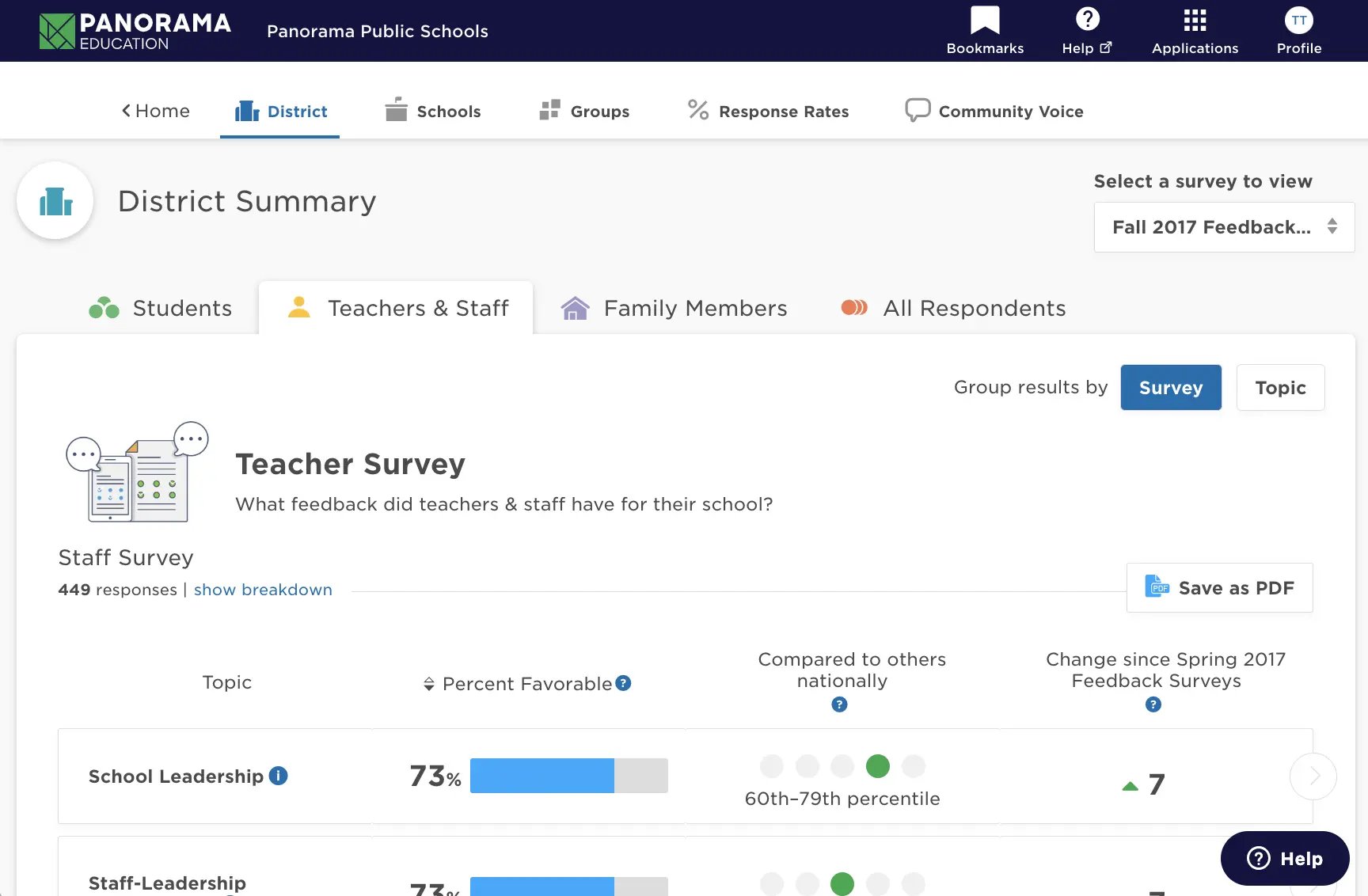Beyond tangible structures and curriculum, a positive school climate is the unseen force that shapes the daily experiences of students, educators, and staff. Feedback from students, staff, and parents is crucial to gaining a comprehensive view of school climate.
From understanding the forces shaping feedback to fostering a culture of feedback and data-informed decision-making, we’re cutting through complexities and diving into why school climate matters for students, teachers, and administrators.
Table of Contents
Why Does School Climate Matter?
Methods for Assessing School Climate
A Culture of Feedback and Data-Informed Decision Making
Creating a Positive School Climate: Next Steps for School and District Leaders
|
Key Takeaways: Significance of School Climate: A positive school climate significantly impacts the daily experiences of students, educators, and staff. Understanding and fostering a positive school climate is essential for enhancing academic outcomes and overall well-being within the educational community. Impact of Positive School Climate: A positive school climate leads to improved academic outcomes, reduced absenteeism, enhanced mental and physical health, decreased negative incidents, and increased staff morale. Creating an environment where community members feel safe, engaged, and supported is key to fostering a positive school climate. Methods for Assessing School Climate: Measurement is crucial for cultivating a positive school climate. Reliable assessment tools, such as surveys and observation measures, allow districts to understand diverse perspectives and monitor the effectiveness of initiatives. Continuous feedback loops ensure that strategies are responsive to the evolving needs of the school community. Factors Impacting Feedback: Relational trust and time are significant factors that influence the quality of feedback collected. Building trust through transparency and reciprocity, and strategically allocating time for feedback initiatives, are essential for optimizing engagement and ensuring high-quality responses. |
What is School Climate?
“School climate refers to the quality and character of school life. School climate is based on patterns of students, parents and school personnel’s experience of school life and reflects norms, goals, values, interpersonal relationships, teaching and learning practices, and organizational structures.”
–National School Climate Center
The complexity of this definition may initially seem overwhelming. However, breaking down this definition reveals not just challenges but opportunities—multiple levers through which school climate can be positively influenced.
Examining the relatedness of these components and recognizing their variety allows us to view each element as a potential avenue for impact. District and school administrators have various entry points to address and enhance school climate.
Moreover, acknowledging the diverse stakeholders involved in shaping school climate is key. The experiences of students, parents, and employees collectively contribute to the overall climate. So the ability to capture and understand these varied experiences is a crucial aspect of nurturing a positive school climate.
Why Does School Climate Matter?
A positive school climate, where community members feel safe, engaged, and nurtured, directly influences key aspects of the educational journey. When students feel like they belong, their academic performance flourishes. This extends into:
- Improved academic outcomes, such as higher GPAs and graduation rates
- Decreased absenteeism
- Improved mental and physical health
- Reduced negative incidents, such as substance abuse
- Lower rates of suspension
And the impact isn't limited to students alone. Improved staff morale is a key indicator of a positive school climate. When educators and staff feel valued and supported, their enthusiasm and commitment to their roles amplify. This positive dynamic further contributes to a collaborative and effective educational environment.
In essence, a positive school climate shapes not only academic outcomes, but also the overall well-being of the entire educational community. As we delve deeper into this exploration, we'll discuss strategies and tools, such as Panorama’s School Climate Surveys, that empower educational leaders to measure, address, and enhance school climate for the benefit of all stakeholders.
Methods for Assessing School Climate
Measurement is at the core of cultivating a positive school climate. Districts must use quality assessment tools to understand student, family, and staff perception.
Implementing reliable and valid surveys, alongside observation measures, is a crucial practice for gaining insights into the diverse perspectives that shape school life. Understanding the perceptions of students, families, school personnel, community members, and other relevant groups is foundational in making informed decisions that align with the unique dynamics of your school community.
Equally important is the ability to monitor and evaluate the impact of these actions. A continuous feedback loop ensures that initiatives are effective, allowing districts to adapt and refine strategies based on real-time data. This dual approach of understanding perceptions and monitoring outcomes creates a dynamic framework for addressing school climate, fostering an environment where every voice is heard and every perspective is valued.
What Factors Impact Feedback?
While many factors can impact the quality of feedback collected, two major forces that should be considered before introducing measures into the educational environment are relational trust and time.
Relational Trust
One critical force is relational trust—an element that influences not only who participates in surveys, but also how they respond to them. Panorama's Senior Research Scientist, Dr. David Kowalski explains relational trust in regard to survey completion: “It’s really a fancy way of saying 'If I don’t trust you, I’m not going to fill out this survey. And if I don’t trust you, I’m probably not going to put a lot of stock into the data that comes in.'”
To nurture this relational trust, transparency is essential. For example, sharing survey findings with students creates a loop of trust, conveying that their feedback is not only valued, but actively used to drive positive change. For school leaders, reciprocity plays a pivotal role. Soliciting feedback from staff fosters an environment where feedback isn't just a one-way street, cultivating a symbiotic relationship that strengthens relational trust within the school community at multiple levels.
Time
It can take significant time for students, staff, and families to complete surveys with quality answers. So time is an investment that must be prioritized and sufficiently allocated. Strategic decisions can maximize the effectiveness of this time, including:
- Gathering only the necessary data
- Being deliberate about when and how time is structured for feedback
- Meeting participants where they are in their schedules
By aligning feedback initiatives with the rhythm of daily school life, schools can optimize engagement and ensure high-quality responses.
A Culture of Feedback and Data-Informed Decision-Making
Building a culture of feedback within schools goes beyond the act of gathering information; it necessitates the integration of valuable feedback with other data for informed decision-making. This process is nuanced and requires a strategic approach.
Data analysis is a powerful informing factor, but it doesn't replace the expertise and judgment of proficient educators. Kowalski uses an apt analogy to describe data-informed decision-making: “I will let data join me in the car, but I never let data drive for me.”
Distinguishing between data-informed decision-making and data-driven decision-making is crucial. Whereas data-driven decisions place data at the forefront, data-informed decision-making recognizes the collaborative relationship between data and educators' expertise.
Effective data-informed decision-making relies on several foundational elements:
- Structures for Listening: Implementing tools like surveys and discussion groups establishes structures that actively listen to the voices of students, staff, and other stakeholders. This provides a comprehensive understanding of the school climate.
- Relevant, Easily Located, Timely Data: Access to data should be seamless and timely. Schools must ensure that the information is not only relevant to their objectives, but is also readily available when needed.
- Norms for Analysis and Interpretation: Establishing norms that guide structured analysis and interpretation of data ensures consistency and precision in decision-making processes.
- Data Expertise and Supports: Equipping educators with tools that facilitate interpretation and translate raw data into actionable insights is imperative for successful data-informed decision-making.
- Collaboration: Fostering a collaborative environment increases the likelihood of well-informed decisions. When various perspectives come together, decisions become more comprehensive and reflective of the diverse needs of the school community.
|
Frequently Asked Questions: How can our district effectively assess school climate to gain insights into the needs and experiences of our educational community? How can our district ensure high participation rates in school climate assessment efforts to gather comprehensive data from all stakeholders? What steps can our district take to build relational trust and allocate sufficient time for feedback initiatives to enhance the quality of data collected? |
Creating a Positive School Climate: Next Steps for School and District Leaders
Creating a positive school climate requires strategic steps and the right resources. To lay the foundation, it's crucial to employ high-quality instruments for data collection which allow you to capture diverse perspectives from across your district.

With Panorama’s Surveys, you can feel confident in the validity and reliability of your results, knowing you've reached every member of your community. Moreover, armed with robust analytics in a platform like Student Success, you're equipped to transform survey responses into actionable strategies that make a lasting positive impact.






